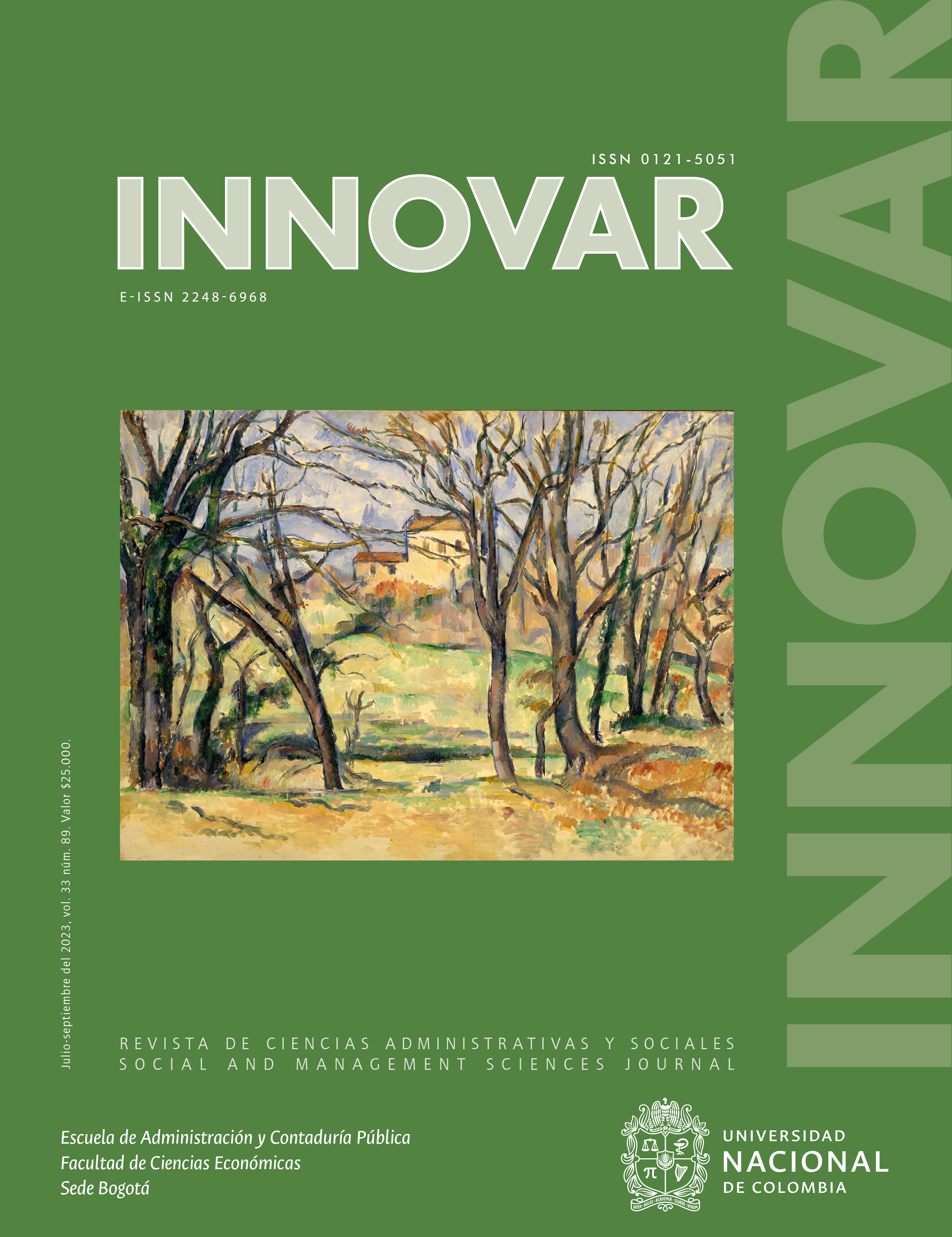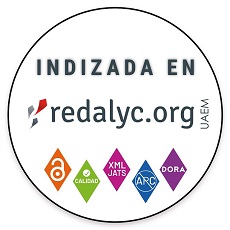Efecto de la turbulencia tecnológica generada por la inteligencia artificial en la innovación de producto: el papel de la orientación estratégica a la digitalización
Effects Of The Technological Turbulence Created By Artificial Intelligence On Product Innovation: The Role Of Strategic Orientation Towards Digitization
Efeito da turbulência tecnológica gerada pela inteligência artificial na inovação de produto: o papel da orientação estratégica à digitalização
DOI:
https://doi.org/10.15446/innovar.v33n89.107036Palabras clave:
innovación tecnológica, innovación digital, inteligencia artificial, orientación estratégica, transformación digital (es)Technological innovation, digital innovation, artificial intelligence, strategic orientation, digital transformation (en)
inovação tecnológica, inovação digital, inteligência artificial, orientação estratégica, transformação digital (pt)
La inteligencia artificial genera turbulencia en el entorno de las empresas, que se han visto obligadas a priorizar su adopción para mantenerse competitivas. Los robots se ocupan de procesar grandes cantidades de datos, además de mejorar la eficiencia operativa y la experiencia del cliente; sin embargo, su papel ha sido estudiado desde una perspectiva estrictamente técnica y operativa. El objetivo de este artículo es analizar el rol mediador de la orientación estratégica a la digitalización en la relación entre turbulencia tecnológica generada por la inteligencia artificial e innovación de producto, como una variable clave que puede facilitar el aprovechamiento adecuado y sistemático de la inteligencia artificial. El modelo de investigación se testeó mediante ecuaciones estructurales en una muestra de empresas en sectores en donde la adopción de robots inteligentes va en aumento. Los resultados muestran que la totalidad de la varianza de la innovación de producto está explicada por el efecto indirecto de la orientación estratégica a la digitalización. Por lo tanto, la innovación de producto depende de forma exclusiva de cuán determinada está la empresa a aprovechar las oportunidades que ofrecen las nuevas tecnologías digitales, más que de la presión externa generada por la inteligencia artificial.
Artificial intelligence (ai) has generated turbulence in the business environment, so companies have been forced to prioritize its adoption to remain competitive. Robots deal with the processing of enormous amounts of data, in addition to improving operational efficiency and customer experience. However, their role has been studied from a strictly technical and operational perspective. Therefore, the objective of this article is to study the mediating role of the strategic orientation towards digitization in the relationship between ai-driven technological turbulence and product innovation, as a key variable that could foster the adequate and systematic use of ai. The research model was tested using structural equations in a sample of companies in sectors where intelligent robots’ adoption is increasing. The results show that the entire variance of product innovation is explained by the indirect effect of the strategic orientation towards digitization. Consequently, product innovation depends exclusively on how determined the company is to take advantage of the opportunities offered by new digital technologies, rather than on the external pressure generated by ai.
A inteligência artificial gera turbulência no entorno das empresas, que são vistas obrigadas a priorizar sua adoção para se manterem competitivas. Os robôs se ocupam de processar grandes quantidades de dados, além de melhorar a eficiência operacional e a experiência do cliente; contudo, seu papel tem sido estudado sob uma perspectiva estritamente técnica e operacional. O objetivo deste artigo é analisar o papel mediador da orientação estratégica à digitalização na relação entre turbulência tecnológica gerada pela inteligência artificial e inovação de produto, como uma variável-chave que pode facilitar o aproveitamento adequado e sistemático da inteligência artificial. O modelo de pesquisa foi testado mediante equações estruturais numa amostra de empresas em setores em que a adoção de robôs inteligentes vai em ascensão. Os resultados mostram que a totalidade da variância da inovação de produto está explicada pelo efeito indireto da orientação estratégica à digitalização. Portanto, a inovação de produto depende de forma exclusiva de quão determinada a empresa está para aproveitar as oportunidades que as novas tecnologias digitais oferecem mais do que da pressão externa gerada pela inteligência artificial.
Referencias
Abbas, M. W., & Ul Hassan, M. (2017). Moderating impact of environmental turbulence on business innovation and business performance. Pakistan Journal of Commerce and Social Sciences (PJCSS), 11(2), 576-596.
Aime, F., Humphrey, S., DeRue, D. S., & Paul, J. B. (2014). The riddle of heterarchy: Power transitions in cross-functional teams. Academy of Management Journal, 57(2), 327-352. https://doi.org/10.5465/amj.2011.0756
Akerkar, R. (2019). Artificial intelligence for business. Springer. https://doi.org/10.1007/978-3-319-97436-1
Al-Hashem, A. O. (2020). Mediation impact of marketing intelligence in the relationship between technology based knowledge sharing and product innovation. TEM Journal, 9(2), 688-693. https://doi.org/10.18421/TEM92-35
Alavi, M., & Leidner, D. E. (2001). Review: Knowledge management and knowledge management systems: Conceptual foundations and research issues. MIS Quarterly, 25(1), 107-136. https://doi.org/10.2307/3250961
Alexy, O., George, G., & Salter, A. J. (2013). Cui Bono? The selective revealing of knowledge and its implications for innovative activity. Academy of Management Review, 38(2), 270-291. https://doi.org/10.5465/AMR.2011.0193
Ardolino, M., Rapaccini, M., Saccani, N., Gaiardelli, P., Crespi, G., & Ruggeri, C. (2018). The role of digital technologies for the service transformation of industrial companies. International Journal of Production Research, 56(6), 2116-2132. https://doi.org/10.1080/00207543.2017.1324224
Arenal, A., Armuña, C., Feijoo, C., Ramos, S., Xu, Z., & Moreno, A. (2020). Innovation ecosystems theory revisited: The case of artificial intelligence in China. Telecommunications Policy, 44(6), 101960. https://doi.org/10.1016/j.telpol.2020.101960
Arias-Pérez, J., & Cepeda-Cardona, J. (2022). Knowledge management strategies and organizational improvisation: What changed after the emergence of technological turbulence caused by artificial intelligence? Baltic Journal of Management, 17(2), 250-265. https://doi.org/10.1108/BJM-01-2021-0027
Arias-Pérez, J., & Vélez-Jaramillo, J. (2022). Understanding knowledge hiding under technological turbulence caused by artificial intelligence and robotics. Journal of Knowledge Management, 26(6), 1476-1491. https://doi.org/10.1108/JKM-01-2021-0058
Arias-Pérez, J., Velez-Ocampo, J., & Cepeda-Cardona, J. (2021). Strategic orientation toward digitalization to improve innovation capability: Why knowledge acquisition and exploitation through external embeddedness matter? Journal of Knowledge Management, 25(5), 1319-1335. https://doi.org/10.1108/JKM-03-2020-0231
Aydin, H. (2020). Market orientation and product innovation: The mediating role of technological capability. European Journal of Innovation Management, 24(4), 1233-1267. https://doi.org/10.1108/EJIM-10-2019-0274
Barro, S., & Davenport, T. H. (2019). People and machines: Partners in innovation. MIT Sloan Management Review, 60(4). https://sloanreview.mit.edu/article/people-and-machines-partners-in-innovation/
Bodlaj, M., & Čater, B. (2019). The impact of environmental turbulence on the perceived importance of innovation and innovativeness in SMEs. Journal of Small Business Management, 57(S2), 417-435. https://doi.org/10.1111/jsbm.12482
Bogers, M., Zobel A.-K.,Afuah, A., Almirall, E., Brunswicker, S., Dahlander, L., Frederiksen, L., Gawer, A., Gruber, M., Haefliger, S., Hagedoorn, J., Hilgers, D., Laursen, K., Magnusson, M. G., Majchrzak, A., McCarthy, I. P., Moeslein, K. M., Nambisan, S., Piller, F. T., Radziwon, A., ... Ter Wal, A. L. (2017). The open innovation research landscape: Established perspectives and emerging themes across different levels of analysis. Industry and Innovation, 24(1), 8-40. https://doi.org/10.1080/13662716.2016.1240068
Bogers, M., Chesbrough, H., Heaton, S., & Teece, D. J. (2019). Strategic management of open innovation: A dynamic capabilities perspective. California Management Review, 62(1), 77-94. https://doi.org/10.1177/0008125619885150
Butner, K., & Ho, G. (2019). How the human-machine interchange will transform business operations. Strategy & Leadership, 47(2), 25-33. https://doi.org/10.1108/SL-01-2019-0003
Castellacci, F. (2011). Closing the technology gap? Review of Development Economics, 15(1), 180-197. https://doi.org/10.1111/j.1467-9361.2010.00601.x
Celtekligil, K., & Adiguzel, Z. (2019). Analysis of the effect of innovation strategy and technological turbulence on competitive capabilities and organizational innovativeness in technology firms. Procedia Computer Science, 158, 772-780. https://doi.org/10.1016/j.procs.2019.09.114
Chen, T., Li, F., Chen, X.-P., & Ou, Z. (2018). Innovate or die: How should knowledge-worker teams respond to technological turbulence? Organizational Behavior and Human Decision Processes, 149, 1-16. https://doi.org/10.1016/j.obhdp.2018.08.008
Choi, M. J., Kim, S., & Park, H. (2018). Empirical study on the factors influencing process innovation when adopting intelligent robots at small- and medium-sized enterprises-The role of organizational supports. Information, 9(315). https://doi.org/10.3390/info9120315
Choudhury, P., Starr, E., & Agarwal, R. (2020). Machine learning and human capital complementarities: Experimental evidence on bias mitigation. Strategic Management Journal, 41(8), 1381-1411. https://doi.org/10.1002/smj.3152
Davenport, T., Guha, A., Grewal, D., & Bressgott, T. (2020). How artificial intelligence will change the future of marketing. Journal of the Academy of Marketing Science, 48(1), 24-42. https://doi.org/10.1007/s11747-019-00696-0
Deloitte. (2017). Bullish on the business value of cognitive. Leaders in cognitive and AI weigh in on what’s working and what’s next. Deloitte. https://www2.deloitte.com/content/dam/Deloitte/us/Documents/deloitte-analytics/us-da-2017-deloitte-state-of-cognitive-survey.pdf
Deloitte & Confederation of Indian Industry. (2018). Knowledge management & big data making smart enterprise a reality. Deloitte. https://www2.deloitte.com/in/en/pages/technology-media-and-telecommunications/articles/knowledge-management-big-data.html
Díaz Pinzón, B. H., Gómez Medina, J. S., García González, J. D., Melo Román, H. A., & Sanabria Villamizar, F. E. (2017). Contribución de las iniciativas de tecnologías de la información en las organizaciones: una revisión de la literatura. Innovar, 27(66), 41-55. https://doi.org/10.15446/innovar.v27n66.66710
Dongling, W., & Lam, K. C. K. (2019). The impact of inter-organizational Guanxi, organizational learning on innovation performance: An empirical study from the Chinese market. International Journal of Organizational Innovation, 11(3), 185-196. https://www.ijoi-online.org/attachments/article/110/0906%20Final.pdf
Eurostat. (2009). ‘High-technology’and ‘knowledge based services’ Aggregations Based on NACE Rev. 2. Eurostat. https://www.statistik.at/stddoku/subdokumente/b_f-e_firmeneig_bereich_high_tech_sectors_nace_rev_2.pdf
Fossas-Olalla, M., Minguela-Rata, B., López-Sánchez, J. I., & Fernández-Menéndez, J. (2015). Product innovation: When should suppliers begin to collaborate? Journal of Business Research, 68(7), 1404-1406. https://doi.org/10.1016/j.jbusres.2015.01.022
Fountaine, T., McCarthy, B., & Saleh, T. (2019). Building the AI-powered organization. Harvard Business Review. https://hbr.org/2019/07/building-the-ai-powered-organization
Gallego Bono, J. R. (2016). Fragmentación de las redes de innovación y dinámica de los sistemas territoriales de producción y de innovación en sectores tradicionales. Innovar, 26(62), 23-40. https://doi.org/10.15446/innovar.v26n62.59386
Gatignon, H., & Xuereb, J.-M. (1997). Strategic orientation of the firm and new product performance. Journal of Marketing Research, 34(1), 77-90. https://doi.org/10.2307/3152066
Ghosh, B., Wilson, J., Burden, A., & Daugherty, P. (2019, mayo 9). Taking a systems approach to adopting AI. Harvard Business Review. https://hbr.org/2019/05/taking-a-systems-approach-to-adopting-ai
Gkypali, A., Filiou, D., & Tsekouras, K. (2017). R&D collaborations: Is diversity enhancing innovation performance? Technological Forecasting and Social Change, 118, 143-152. https://doi.org/10.1016/j.techfore.2017.02.015
Glikson, E., & Williams Woolley, A. (2020). Human trust in artificial intelligence: Review of empirical research. Academy of Management Annals, 14(2), 627-660. https://doi.org/10.5465/annals.2018.0057
Gómez Rodríguez, M. E., Villalba Morales, M. L., & Pérez Valencia, D. M. (2020). Comparative analysis of technological innovation capabilities in the Colombian manufacturing industry, 2006-2014. A review based on the latent class analysis method. Innovar, 30(77), 93-106. https://doi.org/10.15446/innovar.v30n77.87451
Grant, R. M. (1996). Toward a knowledge-based theory of the firm. Strategic Management Journal, 17(S2), 109-122. https://doi.org/10.1002/smj.4250171110
Guo, H., Wang, C., Su, Z., & Wang, D. (2020). Technology push or market pull? Strategic orientation in business model design and digital start-up performance. Journal of Product Innovation Management, 37(4), 352-372. https://doi.org/10.1111/JPIM.12526
Hair, J., Howard, M., & Nitzl, C. (2020). Assessing measurement model quality in PLS-SEM using confirmatory composite analysis. Journal of Business Research, 109, 101-110. https://doi.org/10.1016/j.jbusres.2019.11.069
Hair, J. F., Hult, G. T. M., Ringle, C. M., & Sarstedt, M. (Eds.). (2017). A primer on partial least squares structural equations modeling (PLS-SEM). SAGE. DOI: https://doi.org/10.15358/9783800653614
Hair, J. F., Hult, G. T. M., Ringle, C. M., & Sarstedt, M. (Eds.). (2021). A primer on partial least squares structural equation modeling (PLS-SEM). SAGE. DOI: https://doi.org/10.1007/978-3-030-80519-7
Hair, J. F., Risher, J., Sarstedt, M., & Ringle, C. (2019). When to use and how to report the results of PLS-SEM. European Business Review, 31(1), 2-24. https://doi.org/10.1108/EBR-11-2018-0203
Halac, D. S. (2015). Multidimensional construct of technology orientation. Procedia - Social and Behavioral Sciences, 195, 1057-1065. https://doi.org/10.1016/J.SBSPRO.2015.06.149
Hoffmann, J., Ramirez, R., & Lecamp, L. (2018). Right on time - Socioecological strategy and implications of turbulence in the Swiss watchmaking field. Technological Forecasting and Social Change, 137, 101-117. https://doi.org/10.1016/j.techfore.2018.06.047
Jiang, X., Yang, Y., Pei, Y. L., & Wang, G. (2016). Entrepreneurial orientation, strategic alliances, and firm performance: Inside the black box. Long Range Planning, 49(1), 103-116. https://doi.org/10.1016/j.lrp.2014.09.003
Kaplan, A., & Haenlein, M. (2020). Rulers of the world, unite! The challenges and opportunities of artificial intelligence. Business Horizons, 63(1), 37-50. https://doi.org/10.1016/j.bushor.2019.09.003
Khin, S., & Ho, T. C. (2019). Digital technology, digital capability and organizational performance: A mediating role of digital innovation. International Journal of Innovation Science, 11(2), 177-195. https://doi.org/10.1108/IJIS-08-2018-0083
Kogut, B., & Zander, U. (1992). Knowledge of the firm, combinative capabilities, and the replication of technology. Organization Science, 3(3), 383-397. https://doi.org/10.1287/orsc.3.3.383
Lee, H. (2017). When and to whom does trust have a positive effect? Interaction among trust, technological turbulence and organizational culture. Journal of Marketing Thought, 3(4), 35-42.
Li, Y., Kwok, R. C. W., Zhang, S., & Gao, S. (2020). How could firms benefit more from absorptive capacity under technological turbulence? The contingent effect of managerial mechanisms. Asian Journal of Technology Innovation, 28(1), 1-20. https://doi.org/10.1080/19761597.2019.1686708
Liao, S. H., Fei, W. C., & Chen, C. C. (2007). Knowledge sharing, absorptive capacity, and innovation capability: an empirical study of Taiwan's knowledge-intensive industries. Journal of information science, 33(3), 340-359. https://doi.org/10.1177/0165551506070
Martín‐de Castro, G., López-Sáez, P., & Delgado‐Verde, M. (2011). Towards a knowledge‐based view of firm innovation. Theory and empirical research. Journal of Knowledge Management, 15(6), 871-874. https://doi.org/10.1108/13673271111179253
Martin, S. L., Javalgi, R. G., & Ciravegna, L. (2020). Marketing capabilities and international new venture performance: The mediation role of marketing communication and the moderation effect of technological turbulence. Journal of Business Research, 107, 25-37. https://doi.org/10.1016/j.jbusres.2019.09.044
Martínez-Senra, A. I., Quintás, M. A., & Caballero, G. (2014). La investigación básica en las empresas innovadoras españolas: un análisis exploratorio. Innovar, 24(52), 79-88. https://doi.org/10.15446/innovar.v24n52.42524
Maxwell, M. (2017). The relationship between external turbulence and new product development practices [Tesis doctoral, Nova Southeastern University]. NSU Works. https://nsuworks.nova.edu/hsbe_etd/132/
Murray, A., Rhymer, J., & Sirmon, D. G. (2020). Humans and technology: Forms of conjoined agency in organizations. Academy of Management Review, 46(3), 552-571. https://doi.org/10.5465/amr.2019.0186
Neştian, A., Tiţă, S., & Guţă, A. L. (2020). Incorporating artificial intelligence in knowledge creation processes in organizations. Proceedings of the International Conference on Business Excellence, 14(1), 597-606. https://doi.org/10.2478/picbe-2020-0056
Nonaka, I., & Takeuchi, H. (1995). The knowledge-creating company: How Japanese companies create the dynamics of innovation. Oxford University Press. DOI: https://doi.org/10.1016/0024-6301(96)81509-3
Ogbeibu, S., Emelifeonwu, J., Senadjki, A., Gaskin, J., & Kaivo-oja, J. (2020). Technological turbulence and greening of team creativity, product innovation, and human resource management: Implications for sustainability. Journal of Cleaner Production, 244, 118703. https://doi.org/https://doi.org/10.1016/j.jclepro.2019.118703
Organización para la Cooperación y el Desarrollo Económicos (OCDE). (2005). Manual de Oslo. Guía para la recogida e interpretación de datos sobre innovación. OCDE; Eurostat. https://doi.org/10.1787/9789264065659-es
Pratono, A. H. (2016). Strategic orientation and information technological turbulence: Contingency perspective in SMEs. Business Process Management Journal, 22(2), 368-382. https://doi.org/10.1108/BPMJ-05-2015-0066
Pratono, A. H. (2018). Does firm performance increase with risk-taking behavior under information technological turbulence? Empirical evidence from Indonesian SMEs. Journal of Risk Finance, 19(4), 361-378. https://doi.org/10.1108/JRF-10-2017-0170
Qi, Y., Mao, Z., Zhang, M., & Guo, H. (2020). Manufacturing practices and servitization: The role of mass customization and product innovation capabilities. International Journal of Production Economics, 228, 107747. https://doi.org/10.1016/j.ijpe.2020.107747
Quinton, S., Canhoto, A., Molinillo, S., Pera, R., & Budhathoki, T. (2018). Conceptualising a digital orientation: antecedents of supporting SME performance in the digital economy. Journal of Strategic Marketing, 26(5), 427-439. https://doi.org/10.1080/0965254X.2016.1258004
Rahim, F. B. T., & Zainuddin, Y. (2017). Moderating effect of environmental turbulence on firm’s technological innovation capabilities (TIC) and business performance in the automotive industry in Malaysia: A conceptual framework. MATEC Web of Conferences, 90. https://doi.org/10.1051/matecconf/20179001009
Ransbotham, S., Kiron, D., Gerbert, P., & Reeves, M. (2017). Reshaping business with artificial intelligence: Closing the gap between ambition and action. MIT Sloan Management Review, 59(1), 1-17. https://sloanreview.mit.edu/projects/reshaping-business-with-artificial-intelligence/
Sahi, G. K., Gupta, M. C., Cheng, T. C. E., & Lonial, S. C. (2019). Relating entrepreneurial orientation with operational responsiveness: Roles of competitive intensity and technological turbulence. International Journal of Operations and Production Management, 39(5), 739-766. https://doi.org/10.1108/IJOPM-07-2018-0411
Samaniego Alcántar, Á. S., & Mongrut, S. (2014). Relación entre la creación de valor y la inversión en I+D: una aproximación mediante redes neuronales artificiales. Innovar, 24(51), 19-29. https://doi.org/10.15446/innovar.v24n51.41236
Shan, J., & Jolly, D. R. (2013). Technological innovation capabilities, product strategy, and firm performance: The electronics industry in China. Canadian Journal of Administrative Sciences, 30(3), 159-172. https://doi.org/10.1002/cjas.1256
Shrestha, Y. R., Ben-Menahem, S. M., & von Krogh, G. (2019). Organizational decision-making structures in the age of artificial intelligence. California Management Review, 61(4), 66-83. https://doi.org/10.1177/0008125619862257
Slater, S. F., Mohr, J. J., & Sengupta, S. (2014). Radical product innovation capability: Literature review, synthesis, and illustrative research propositions. Journal of Product Innovation Management, 31(3), 552-566. https://doi.org/10.1111/jpim.12113
Slavec Gomezel, A., & Aleksić, D. (2020). The relationships between technological turbulence, flow experience, innovation performance and small firm growth. Journal of Business Economics and Management, 21(3), 760-782. https://doi.org/10.3846/jbem.2020.12280
Sok, P., & O’Cass, A. (2011). Achieving superior innovation-based performance outcomes in SMEs through innovation resource–capability complementarity. Industrial Marketing Management, 40(8), 1285-1293. https://doi.org/10.1016/j.indmarman.2011.10.007
Solis Vázquez, S. Y., García Fernández, F., & Zerón Félix, M. (2017). Impacto de la capacidad de absorción del conocimiento en la innovación. El caso del sector petroquímico en Reynosa, México. Innovar, 27(66), 11-27. https://doi.org/10.15446/innovar.v27n66.66708
Srinivasan, M., Srivastava, P., & Iyer, K. N. S. (2020). An empirical model of salesperson competence, buyer-seller trust and collaboration: The moderating role of technological turbulence and product complexity. Journal of Marketing Theory and Practice, 28(4), 447-459. https://doi.org/10.1080/10696679.2020.1781539
Srivastava, P., Iyer, K. N. S., & Rawwas, M. Y. A. (2017). Performance impact of supply chain partnership strategy-environment co-alignment. International Journal of Operations & Production Management, 37(7), 927-949. https://doi.org/10.1108/ijopm-09-2015-0586
Tutar, H., Nart, S., & Bingöl, D. (2015). The effects of strategic orientations on innovation capabilities and market performance: The case of ASEM. Procedia - Social and Behavioral Sciences, 207, 709-719. https://doi.org/10.1016/j.sbspro.2015.10.144
Ullah, A., Iqbal, S., & Shams, S. M. R. (2020). Impact of CRM adoption on organizational performance: Moderating role of technological turbulence. Competitiveness Review, 30(1), 59-77. https://doi.org/10.1108/CR-11-2019-0128
Vargas Martínez, E. E., Bahena Álvarez, I. L., & Cordón Pozo, E. (2018). Innovación responsable: nueva estrategia para el emprendimiento de mipymes. Innovar, 28(69), 41-53. https://doi.org/10.15446/innovar.v28n69.71695
Verhoef, P. C., Broekhuizen, T., Bart, Y., Bhattacharya, A., Qi Dong, J., Fabian, N., & Haenlein, M. (2019). Digital transformation: A multidisciplinary reflection and research agenda. Journal of Business Research, 122, 889-901. https://doi.org/10.1016/j.jbusres.2019.09.022
Vial, G. (2019). Understanding digital transformation: A review and a research agenda. The Journal of Strategic Information Systems, 28(2), 118-144. https://doi.org/10.1016/j.jsis.2019.01.003
Von Krogh, G. (2018). Artificial intelligence in organizations: New opportunities for phenomenon-based theorizing. Academy of Management Discoveries, 4(4), 404-409. https://doi.org/10.5465/amd.2018.0084
Wilden, R., & Gudergan, S. P. (2014). The impact of dynamic capabilities on operational marketing and technological capabilities: Investigating the role of environmental turbulence. Journal of the Academy of Marketing Science, 43(2), 181-199. https://doi.org/10.1007/s11747-014-0380-y
Wu, B., Wan, Z., & Levinthal, D. A. (2014). Complementary assets as pipes and prisms: Innovation incentives and trajectory choices. Strategic Management Journal, 35(9), 1257-1278. https://doi.org/10.1002/smj.2159
Zhang, M., Lettice, F., & Zhao, X. (2015). The impact of social capital on mass customisation and product innovation capabilities. International Journal of Production Research, 53(17), 5251-5264. https://doi.org/10.1080/00207543.2015.1015753
Zhao, X., Lynch J. G., & Chen, Q. (2010). Reconsidering Baron and Kenny: Myths and truths about mediation analysis. Journal of Consumer Research, 37(2), 197-206. http://dx.doi.org/10.1086/651257
Zimuto, C., Sandada, M., Chuchu, T., & Ndoro, T. (2019). The impact of environmental turbulence on product innovation in small to medium enterprises in Harare, Zimbabwe. Journal of Economics and Behavioral Studies, 10(6A), 56-63. https://doi.org/10.22610/jebs.v10i6a.2661
Cómo citar
APA
ACM
ACS
ABNT
Chicago
Harvard
IEEE
MLA
Turabian
Vancouver
Descargar cita
Licencia
Derechos de autor 2023 Innovar

Esta obra está bajo una licencia internacional Creative Commons Atribución-NoComercial-CompartirIgual 4.0.
Todos los artículos publicados por Innovar se encuentran disponibles globalmente con acceso abierto y licenciados bajo los términos de Creative Commons Atribución-No_Comercial-Sin_Derivadas 4.0 Internacional (CC BY-NC-ND 4.0).
Una vez seleccionados los artículos para un número, y antes de iniciar la etapa de cuidado y producción editorial, los autores deben firmar una cesión de derechos patrimoniales de su obra. Innovar se ciñe a las normas colombianas en materia de derechos de autor.
El material de esta revista puede ser reproducido o citado con carácter académico, citando la fuente.
Esta obra está bajo una Licencia Creative Commons:





















